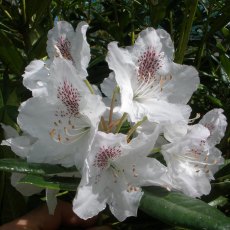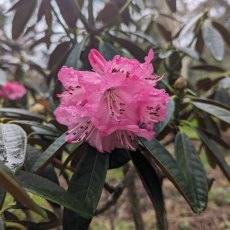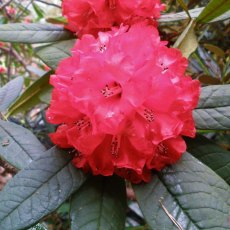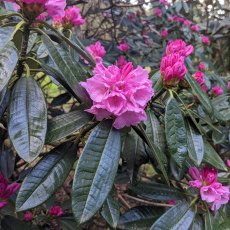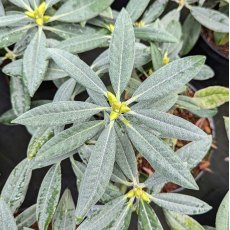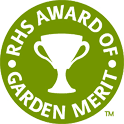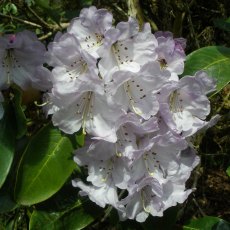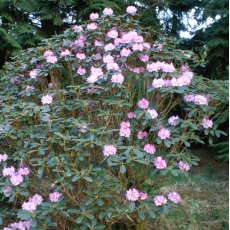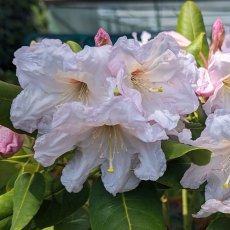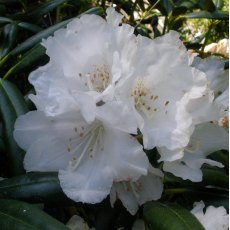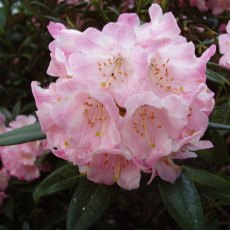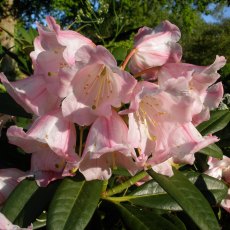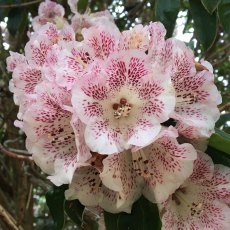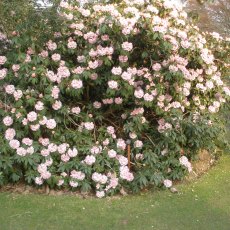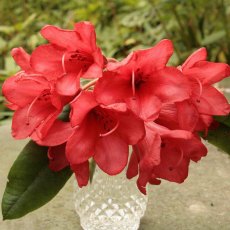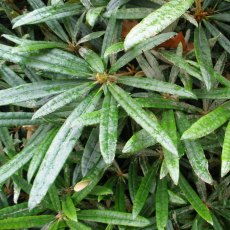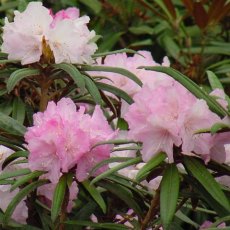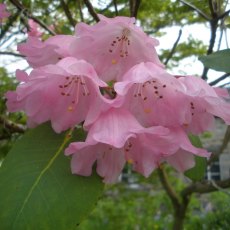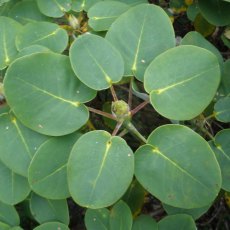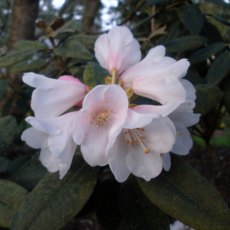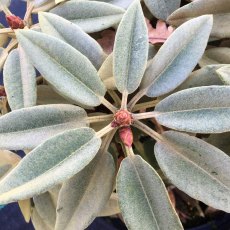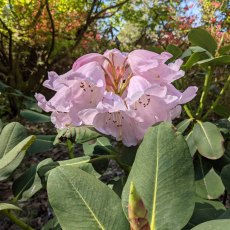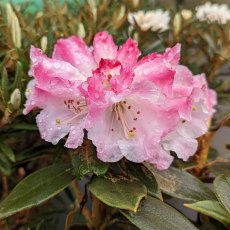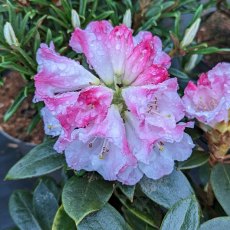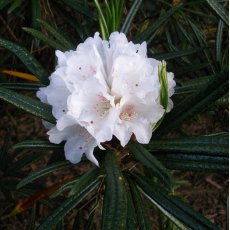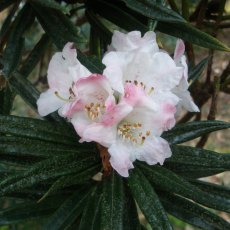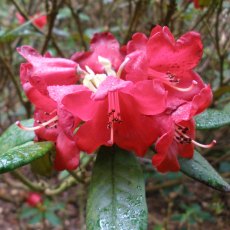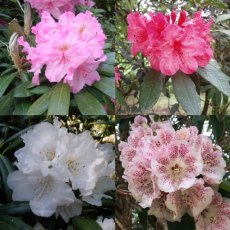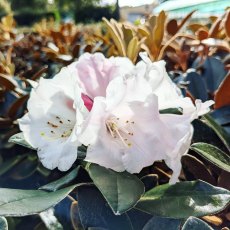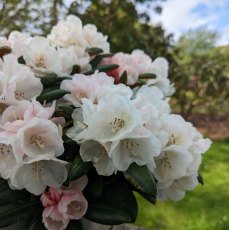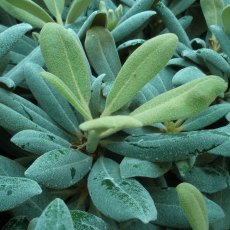Species Rhododendrons
Species Rhododendrons often have wonderful foliage, but are fairly specialist and are best grown by more experienced gardeners.
We pride ourselves in one of the best ranges of Rhododendron species in the country, and we try to propagate these from collectors' seed, or recognised good forms. Many new species Rhododendrons have recently been introduced, mainly from the Himalayas, and we include some for the first time. Many are well worth growing for their foliage alone!
Please note that the flower colour of some species can vary considerably from one clone to the next. eg R. campanulatum can flower from white to pink or deep lilac.
Rhododendron annae
Lovely white open bell shaped flowers, usually with purple spotting, appear in May - June. This plant has interesting dark green narrow leaves and outstanding young foliage. A bushy upright plant that is one of our favourites. Height 125-150cm in 10 years.
Recommended for lovely habit and foliage.
Easy to grow.
Ideal position: sheltered woodland.
Habit: upright.
Group: Species Rhododendron.
Subsection:...
Rhododendron arboreum cinnamomeum 'Everest Reunion'
This plant has neat trusses of pink flowers in March-April. It has distinctive cinnamon red indumentum on the underside of the large leathery leaves. R. arboreum cinnamomeum 'Everest Reunion' makes a good show in our garden and was collected by Colonel Charles Wylie, (David's uncle) who was in charge of logistics and Nepali porters on the successful 1952 Everest expedition. This selection has attractive...
Rhododendron argipeplum (EGM/Borde Hill)
(BARBATA H4-5) Fine scarlet red bell-shaped flowers in a small truss. February-April. Bristly branchlets when young. Reddish smooth and flaking bark. Indumentum under leaf. Height 80-100 cm in 10 years.
Recommended for early flower and interesting bark and foliage.
Plantsman range.
Ideal position: sheltered woodland.
Habit: tree-like.
Group: Species Rhododendron.
Subsection: Barbata.
Introduction...
Rhododendron argyrophyllum 'Chinese Silver' AGM
Red in bud, opening to excellent clear pink bell-shaped flowers, with a darker flushing. Flowering in early May argyrophyllum Chinese Silver is an excellent clone that has attractive dark green silver-backed leaves. Height 125-150cm in 10 years.
Recommended for wonderful foliage.
Easy to grow.
Ideal position: sheltered woodland.
Habit: tree-like.
Group: Species Rhododendron.
Subsection: Argyrophylla.
Introduction...
Rhododendron bureavii AGM
Lovely white rose flushed flowers spotted crimson or purple. Flowering in May this is a superb foliage plant, with thick woolly indumentum on the underside of the leaves turning from white to rusty red with age. One of the most distinctive rhododendron species. Our selected clone is propagated from a large plant growing at Crosswater which has great flowers and grows in a neat rounded habit. It has...
Rhododendron campanulatum
Attractive white, pale rose or lilac flowers, in loose but fairly compact trusses. Flowering in April and May it has lovely glossy leaves up to 18cm long with a continuous fawn/rusty brown indumentum underneath. It makes a fine shrub/small tree. Height 125-150cm in 10 years.
Recommended for outstanding foliage.
Easy to grow.
Ideal position: needs careful site selection, good drainage and not too...
Rhododendron cardiobasis 'Pink Cloud' AC4221
(FORTUNEA H4) Large pinky white funnel shaped campanulate flowers with 7 lobes, late May-June. Distinctive large rounded leaves with a heart shaped base. Related to R. orbiculare. Height 50-75cm in 10 years. Requires moist acid soils.
Rhododendron degronianum heptamerum 'Oki Koki'
(PONTICA H4) Pink in bud, opening to white flowers with a deeper lining in a dense truss during April-May. A tough, neat growing plant forming a dome shape, with dark recurved leaves (130-180 x 40-55mm) and fawn indumentum on the undersides. Height 75-100cm in 10 years.
This plant was selected and named by David Millais from a batch of seed kindly sent by botanist Yuji Kurashige, who collected...
Rhododendron insigne AGM
A great plant with stunning pink bell shaped flowers with crimson spotting in May - June. It has distinctive pointed deep green glossy leaves with a silver/coppery metallic sheen on the underside. This is a tough plant with a neat bushy habit, particularly if grown in plenty of light. It does benefit from deadheading after flowering. Height 80 to 100cm in 10 years.
Recommended for good foliage and...
Rhododendron irroratum 'Polka Dot'
A super selection with striking flowers that are white and heavily spotted deep purple suffused pink in March-April. It has hairy pedicels, ovary and style. This irroratum Polka Dot clone is always one of the most striking flowers on the show benches at Rhododendron competitions. Height 125-150cm in 10 years.
Recommended for striking flowers.
Easy to grow.
Ideal position: sheltered woodland.
Habit:...
Rhododendron kyawii AC3049
(PARISHIA H4-5) Crimson red flowers in June-August. One of the very few species which flower this late in the season which is not white. A relatively tender plant from Burma and North Vietnam, so it does need shelter. A tall growing plant with hairs throughout most parts. Height 150-175cm in 10 years.
Sometimes described incorrectly as R. kwayii.
Sometimes pronounced as R. chaw-ii or R. kye-ii....
Rhododendron makinoi AGM (best narrow leaf)
A stunning plant with compact trusses of pinky white flowers in May and June. This selection has interesting long recurved leaves and dense fawn indumentum on the underside and lovely wooly young shoots. It benefits from staking and is certainly worth growing for it's wonderful foliage. As the name suggests, we think this is our best makinoi selection! Height 80-100cm in 10 years.
Recommended for...
Rhododendron orbiculare (Hydon BH1786) AGM
(FORTUNEA H6) Rose or purplish-pink bell shaped flowers in a loose truss. April-May. Distinct bright green rounded leaves with heart shaped base. Height 80-120cm in 10 years. Best in a fairly sunny spot.
Recommended for distinctive foliage.
Easy to grow.
Ideal position: most sunny garden situations.
Habit: compact and dense.
Group: Species Rhododendron.
Subsection: Fortunea.
Introduction date:...
Rhododendron pachysanthum 'Crosswater' AGM
A superb foliage plant with silvery blue covering (tomentum) on the upper leaf surface, and tan wooly indumentum underneath the leaves that is silvery white on the young growth. Distinctive leaves and free flowering pinky white flowers spotted red or green in April and early May form a neat rounded truss. Originally collected from Taiwan, our pachysanthum Crosswater clone is recognised as one of the...
Rhododendron platypodum
(FORTUNEA H4) Introduced from Sichuan. Pink funnel-campanulate shaped flowers in April-May. Distinctive wide oval pale green leaves, with a flat winged petiole. Height 150-175cm in 10 years.
Rhododendron Pubicostatum
(TALIENSIA H7) Trusses of light pink flowers. April-May. Excellent foliage with sparse brown indumentum on underside. Probably natural hybrid between R. bureavii and R. sikangense. Height 40-60 cm in 10 years.
Rhododendron roxieanum var. oreonastes AGM
Attractive white flowers flushed pink with delicate purple spotting in April - May. This is a wonderful choice foliage plant with dark narrow linear leaves that have an interesting buff indumentum on the underside. This is one of the species most prized by Rhododendron collectors, due to its fantastic foliage. However it can be shy to flower in some years and it dislikes fertilizer.
Recommended...
Rhododendron sanguinium cloiophorum R10922
(NERIIFLORA H6) Crimson scarlet bell shaped flowers, with 5 nectar pouches, in trusses of 2-6 flowers. April-May. Calyx lobes usually deflexed. Leaves with thin white or fawn indumentum. Best in cool moist situations with good drainage. It dislikes most fertilizers, so best feed very lightly with slow release organic feed to prevent scorching. Height 25-50cm in 10 years. .
A slow growing plant, eventually...
Rhododendron Species Collection (4 x 3 litre plants)
Picture for illustration only.
Here's a great offer for anyone who fancies a foray into the species world!.
We grow these plants in 3L pots and we normally sell them for £29.95 each. Heights vary from 50cm to 150cm metres tall in 10 years, variety depending, and often have interesting foliage.
This special offer is for online purchase only, but you can 'Click and Collect' at the checkout if...
Rhododendron tsariense
Gorgeous pinky white flowers with crimson spotting in April. A rare plant with superb foliage that has dense rufous indumentum on the lower leaf surface and sometimes on the upper surface. A lovely compact slow growing plant that needs good drainage to perform well. Avoid using fertilizer with this plant. Height 40-50cm in 10 years.
Ideal for small gardens.
Plantsman range.
Ideal position: sheltered...
Rhododendron yakushimanum 'Koichiro Wada' AGM
Pink in bud opening to delightful white bell shaped flowers giving the appearance of apple blossom, in the form of a compact truss in May. It features a distinctive white fluffy covering (tomentum) on the top of young foliage which washes off during the course of the summer, exposing the dark green glossy upper surface of the leaves. The lower surface of the leaves also starts off with a silvery indumentum...
 Millais Nurseries
Millais Nurseries

